- Published 23 Jan 2023
- Last Modified 29 Aug 2023
- 6 min
A Complete Guide to Fan Speed Controllers

Reviewed by Jay Proctor, Technical Support Team Leader (February 2023)
What is a Fan Speed Controller?
Fan speed controllers are used to control the speed of various kinds of electric fans, including centrifugal fans, extractor fans, propeller fans and axial fans. They increase or decrease fan speeds to reduce wear and tear on equipment, cut noise levels and save energy. Some models are variable, adjusting speed dynamically according to the situation, while others offer a set number of available speeds. An infinitely variable model can be fully adjusted without limitation between 0 and 100 per cent.
They are also known as:
- Fan regulators
- Fan speed regulators
- Fan controllers
What are Fan Speed Controllers Used for?

Fan speed controllers are used in a wide variety of environments. Examples include:
- To control extractor fans in heating, ventilation, and control (HVAC) systems
- To monitor and control CPU fan speeds within laptops and desktop PCs, along with similar devices. Computer CPUs typically generate a lot of heat so rigorous temperature control and ventilation are necessary to prevent overheating. Thermal control fans within PCs, also known as case fans, change direction to maximise ventilation and heat dissipation
- To control other cooling fans in domestic and commercial environments - for example, ceiling fans
How Does a Fan Speed Controller Work?
Fan speed controllers can be divided into five key types.
Conventional models rely on electrical resistance. They contain a wired controller circuit attached to an adjustable dial or toggle for changing the speed of the attached fans. These devices contain wire spools - conductors - with varying amounts of resistance to electrical current. Adjusting the dial on the fan speed control switch aligns a conductor with a particular fan - a process called placing it in series - and the new level of electrical resistance then changes the power reaching the fan, and thereby its speed. Higher levels of resistance will reduce speed or switch off the fan altogether.
However, this electrical resistance produces heat and so uses energy which could potentially match the energy saved by reducing the speed of the fan. Capacitor-based models address this issue by increasing the speed of the fan when the voltage drops - and decreasing it when the power increases. This means that no heat and energy are lost through electrical resistance. A capacitor is a device which stores energy as an electrical charge. The amount it can store is called its capacitance.
Capacitor-based models are typically smaller and provide fine, linear control of speed.
Meanwhile, thermostatic models respond directly to temperature. Sensors monitor the temperature within the chassis and switch the fan on or off according to predefined settings. This reduces fan noise when usage levels are low.
Time switch controllers make use of a timer switch. This is an electrical timer controlling a set of switches. Users can pre-set fans to run at certain times and speeds.
Pulse width modulation (PWM) is the default choice for laptop and PC fan controllers on the circuit boards of computers from many leading manufacturers. PWM provides a way for digital, binary devices like the microcontroller units (MCUs) on circuit boards to control non-digital devices like fans. PWM technology produces short, modulated pulses of voltage to simulate an analogue-style control output. Once in motion, inertia ensures that the fan continues to revolve even during the brief interruptions to power caused by the modulation. The microcontroller, in conjunction with the fan speed software, can make swift, on-the-fly adjustments to cooling fans.
Fan Speed Controller Types
Like most fan components, speed controllers are available in a range of designs for full compatibility with different environments. Let’s look at some of the principal ones.
Circuit Board Type Fan Controllers
Electronic fan speed controllers employ a miniaturised design. Their purpose is to dissipate the significant amounts of heat generated by many computer processors, graphics cards and circuit boards. Software-controlled temperature sensors control the fans via pulse wave modulation technology, making continuous rapid adjustments in response to changing levels of heat within the device.
Variac Style Fan Speed Controllers
Variac devices provide fan speed control by cutting the ongoing power supply to the fan. These manually adjustable devices can control up to two fans with sufficient current. They consist of an electrical transformer containing multiple wire coils, so can be heavy.
Hybrid Fan Speed Controllers
Hybrid fan speed controllers make use of a conventional Variac-style transformer to provide variable-speed fan control. However, this is controlled by an electronic controller circuit. This means that the fan blades are less prone to oscillation and the system can also respond dynamically to changes in temperature.
Fan Speed Controller Brands
Leading fan controller brands include:
ebm-papst
ebm-papst is a German manufacturer of electric motors and fans.
United Automation
United Automation is a UK-based supplier of power control products.
Copal Electronics
Copal Electronics is a Japanese manufacturer of specialist electronic components.
What is the Best Fan Speed Controller?
When looking for the best fan speed controller, it’s important to consider your specific needs and requirements. The type of fans you’re using, the size of your setup, and the level of control you need are all important factors to consider.
One key aspect is compatibility. You will need a model which is fully compatible with the fans you wish to control. This means checking for compatibility with the number of fans, the voltage and amperage requirements, and any other specific features or connections.
Another important factor to consider is the level of control you need. Some fan controllers offer basic on/off functionality, while others offer more advanced controls such as multiple speed settings and remote-control capabilities.
We offer a comprehensive range of fan controllers to help you identify the product that is most suited to your needs. Our offering includes models with different features and capabilities so that you can find the perfect controller for your needs.
FAQs
Further Reading
Related links
- nVent SCHROFF 60118 Series Fan Speed Controller for Use with Fan Variable
- United Automation Fan Speed Controller 15A Max, Infinitely Variable
- ebm-papst DCP Temperature Controller Series Fan Speed Controller...
- LV434211 Series Fan Speed Controller for Use with MasterPact...
- Siemens S55770 Series Fan Speed Controller 6A Max, 3 Speeds
- Vent-Axia T-Series Series Fan Speed Controller for Use with...
- ebm-papst CGC Series Fan Speed Controller for Use with ebm-papst...
- ABB FCC Series Fan Speed Controller for Use with Heating 0 → 10 V, 16A Max





